story and photos by Kayte Deioma
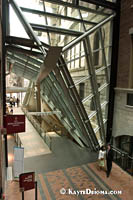 Many cities around the world have created connecting passageways to allow people to walk between buildings protected from the weather. These range from a few shopping galleries extended from a subway station to miles of underground tunnels or above ground skywalks. Montreal has the distinction of having the longest system of interior passages in the world. Officially christened the RESO, a transliteration of the Frenchréseau, meaning network, the 20 miles (32 km) of underground tunnels and ground-level interior walkways connect hotels, apartment buildings, offices, shopping malls, movie theaters, supermarkets, restaurants, museums and local, regional and national train stations.
Many cities around the world have created connecting passageways to allow people to walk between buildings protected from the weather. These range from a few shopping galleries extended from a subway station to miles of underground tunnels or above ground skywalks. Montreal has the distinction of having the longest system of interior passages in the world. Officially christened the RESO, a transliteration of the Frenchréseau, meaning network, the 20 miles (32 km) of underground tunnels and ground-level interior walkways connect hotels, apartment buildings, offices, shopping malls, movie theaters, supermarkets, restaurants, museums and local, regional and national train stations.
Different segments of the Underground City are connected by the metro (subway). Montrealers can leave their apartments and travel across town to work, out to lunch and dinner in different neighborhoods, attend a symphony performance and return home without ever stepping outside. You can do the same thing from your hotel if you stay at any of the nine hotels that are part of the underground system. Even if you don’t have a pressing need to get from here to there, many of the features of this interior world are worth discovering sheerly for their artistic merit or architectural design.
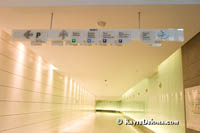 The RESO is not only the longest indoor pedestrian system, it is also used by more people than any other in the world. During rush hour, the corridors between office buildings and metro stations are swarming with commuters. Weekends, the high traffic areas are the shopping and entertainment centers. However, in off-peak hours, especially if the weather is fine, foot traffic is sparse. The entire web of passageways is monitored by video cameras to keep the area secure.
The RESO is not only the longest indoor pedestrian system, it is also used by more people than any other in the world. During rush hour, the corridors between office buildings and metro stations are swarming with commuters. Weekends, the high traffic areas are the shopping and entertainment centers. However, in off-peak hours, especially if the weather is fine, foot traffic is sparse. The entire web of passageways is monitored by video cameras to keep the area secure.
Some areas of the RESO are under development or revitalization. They’re still open and functioning as a way to get from point A to point B, but if you happen to enter the system at one of these spots, you’ll wonder what all the fuss is about. Since there are 20 miles of tunnels to choose from, it helps to decide ahead of time what you want to see and map out a plan.
Hightlights
The main sights on the downtown central segment of the RESO are laid 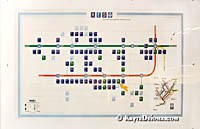 out in a U. The network will be even more user-friendly if they complete the proposed connection of the Place des Arts and the Bay ( La Baie)department store, which would link the top ends of the U, turning it into an O allowing you to circle around in one direction. As it is, most of the hotels are at the bottom of the U, so to see the sights at the top of both branches, you have to walk outside for a few blocks, take the metro one stop or retrace your steps the long way around.
out in a U. The network will be even more user-friendly if they complete the proposed connection of the Place des Arts and the Bay ( La Baie)department store, which would link the top ends of the U, turning it into an O allowing you to circle around in one direction. As it is, most of the hotels are at the bottom of the U, so to see the sights at the top of both branches, you have to walk outside for a few blocks, take the metro one stop or retrace your steps the long way around.
Place des Arts
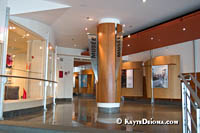 The Hyatt Regency Hotel is an exception. It is located at Complexe Desjardins at the top of the right branch of the U, which also includes office towers and a shopping mall. Complexe Desjardins is linked to the Place des Arts. This visual and performing arts complex was built in the 1960s and expanded in the 1990s. It includes five performance halls and theMuseum of Contemporary Art, all accessible from an indoor atrium. With 2900 seats, the Salle Wilfrid-Pelletier, is the largest multi-use concert hall in Canada. It is home to the Opera of Montreal, the Montreal Symphony Orchestra and Les Grands Ballets Canadiens de Montréal. The smallest of the concert halls, the Cinquičme salle or fifth hall, never got a proper name. It is easy to locate by the scattering of backwards 5s on the floor leading to the entrance.
The Hyatt Regency Hotel is an exception. It is located at Complexe Desjardins at the top of the right branch of the U, which also includes office towers and a shopping mall. Complexe Desjardins is linked to the Place des Arts. This visual and performing arts complex was built in the 1960s and expanded in the 1990s. It includes five performance halls and theMuseum of Contemporary Art, all accessible from an indoor atrium. With 2900 seats, the Salle Wilfrid-Pelletier, is the largest multi-use concert hall in Canada. It is home to the Opera of Montreal, the Montreal Symphony Orchestra and Les Grands Ballets Canadiens de Montréal. The smallest of the concert halls, the Cinquičme salle or fifth hall, never got a proper name. It is easy to locate by the scattering of backwards 5s on the floor leading to the entrance.
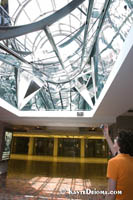 The above-ground square surrounded by these arts institutions is the venue for many of the summer arts events like the Montreal Jazz Festival and the Francofolies French music festival. From the indoor Place des Arts, you have a view through glass of sculptures that are in the outdoor courtyard as well as a variety of interior public art and pieces that are a bit of both. Claude Bettinger’s cylinder of curved glass panes reaches above the ceiling to create a unique skylight and a view into the world outside. If you look closely, you can see the reflection of words etched in reverse: L’artiste est celui qui fait voir l’autre côté des choses(The artist is one who makes you see the other side of things).
The above-ground square surrounded by these arts institutions is the venue for many of the summer arts events like the Montreal Jazz Festival and the Francofolies French music festival. From the indoor Place des Arts, you have a view through glass of sculptures that are in the outdoor courtyard as well as a variety of interior public art and pieces that are a bit of both. Claude Bettinger’s cylinder of curved glass panes reaches above the ceiling to create a unique skylight and a view into the world outside. If you look closely, you can see the reflection of words etched in reverse: L’artiste est celui qui fait voir l’autre côté des choses(The artist is one who makes you see the other side of things).
The Museum of Contemporary Art has an entrance here marked by sleek 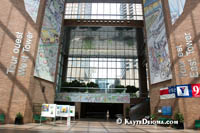 wood and metal signs and panels. If you happen to come by on a winter Monday when the museum is closed, you can get a taste of what’s inside at the museum gift shop La Boutique, which is open seven days.
wood and metal signs and panels. If you happen to come by on a winter Monday when the museum is closed, you can get a taste of what’s inside at the museum gift shop La Boutique, which is open seven days.
Below Complexe Desjardins, Complexe Guy-Favreau holds the main offices of the federal government in Montreal. Multistoried windows between the towers allow natural light into the offices rising above the atrium.
Palais des Congrčs
A brown brick corridor and glass skywalk lead to the Place d’Armes metro<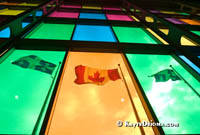 station, which in turn continues to the Palais des Congrčs (Convention Center) in the International Quarter. The Palais des Congrčs expansion was completed in 2002, followed shortly thereafter by completion of the neighboring Caisse de Dépôt building. The two buildings and the park in between now cover the Autoroute Ville-Marie (720), a 10 lane highway which previously separated Old Montreal from Downtown. Now it’s an easy walk from the International Quarter to the old city, although the interior passages stop just short and you have to go the rest of the way outside.
station, which in turn continues to the Palais des Congrčs (Convention Center) in the International Quarter. The Palais des Congrčs expansion was completed in 2002, followed shortly thereafter by completion of the neighboring Caisse de Dépôt building. The two buildings and the park in between now cover the Autoroute Ville-Marie (720), a 10 lane highway which previously separated Old Montreal from Downtown. Now it’s an easy walk from the International Quarter to the old city, although the interior passages stop just short and you have to go the rest of the way outside.
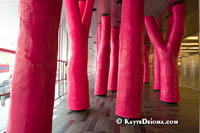 Each of the four façades of the Palais des Congrčs shows a different view to the world. Its interior features include the Lipstick Forest art installation of mock tree trunks painted lipstick pink and the multicolored windows facing Place Jean-Paul Riopelle that create rainbow squares across the escalators and floor when the light hits just right. This gives the building a very cheerful face from the outside as well.
Each of the four façades of the Palais des Congrčs shows a different view to the world. Its interior features include the Lipstick Forest art installation of mock tree trunks painted lipstick pink and the multicolored windows facing Place Jean-Paul Riopelle that create rainbow squares across the escalators and floor when the light hits just right. This gives the building a very cheerful face from the outside as well.
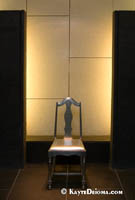 From the Palais des Congrčs you can cross underneath the Place Jean-Paul Riopelle toward the Caisse de Dépôt building or toward the Montreal World Trade Center (Centre de commerce mondial). Neither one of these corridors are lined with shops. They each have their own design personality and incorporate features designed to make them feel more open and less claustrophobic.
From the Palais des Congrčs you can cross underneath the Place Jean-Paul Riopelle toward the Caisse de Dépôt building or toward the Montreal World Trade Center (Centre de commerce mondial). Neither one of these corridors are lined with shops. They each have their own design personality and incorporate features designed to make them feel more open and less claustrophobic.
The Caisse de Dépôt
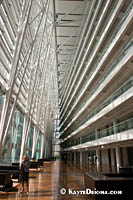 The Caisse de Dépôt et du Placement (CDP) Capital Centre, which was completed just after the convention center expansion, looks like a rather severe glass rectangle from outside. But the ecologically evolved edifice is actually a suspension bridge over the freeway supporting nine stories of offices. The giant 96-foot white cylindrical steel beams supporting the glass structure crisscross the atrium creating a striking pattern along the length of the building. The CDP is the branch of the Quebec government that manages the state’s pension fund, so that’s really a security desk in the lobby, not just a receptionist. A photo display shows how the building was constructed over the freeway.
The Caisse de Dépôt et du Placement (CDP) Capital Centre, which was completed just after the convention center expansion, looks like a rather severe glass rectangle from outside. But the ecologically evolved edifice is actually a suspension bridge over the freeway supporting nine stories of offices. The giant 96-foot white cylindrical steel beams supporting the glass structure crisscross the atrium creating a striking pattern along the length of the building. The CDP is the branch of the Quebec government that manages the state’s pension fund, so that’s really a security desk in the lobby, not just a receptionist. A photo display shows how the building was constructed over the freeway.
World Trade Center
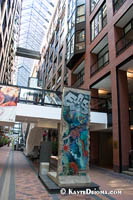 There used to be a gap between the Palais des Congrčs and the Montreal World Trade Center, but the recent additions have connected the two, finishing the bottom of the U. The newest halls incorporate public art as well as installations sponsored by various Montreal art museums.
There used to be a gap between the Palais des Congrčs and the Montreal World Trade Center, but the recent additions have connected the two, finishing the bottom of the U. The newest halls incorporate public art as well as installations sponsored by various Montreal art museums.
From the Palais des Congrés, the RESO enters the World Trade Center complex through a peaked glass portal whose angle preserves the back wall of the historic St. James Hotel. You emerge into what used to be Fortification Lane. The old walls to the old city once stood here. The lane is now an indoor passage between two rows of buildings with a glass roof high above. On the right is the InteContinental Hotel. On the left is the St. James Hotel, also known locally as the “movie star hotel.” It is the most expensive hotel in Montreal.
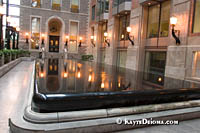 An escalator leads down to shop level where you’ll find an information desk, a few shops, a food court and a piece of the Berlin Wall. At the far end, the complex incorporates the Nordheimer Building, built in 1888. In front of it is a glassy 18 th century fountain by French architect and sculptor Dieudonné-Barthélemy Guibal.
An escalator leads down to shop level where you’ll find an information desk, a few shops, a food court and a piece of the Berlin Wall. At the far end, the complex incorporates the Nordheimer Building, built in 1888. In front of it is a glassy 18 th century fountain by French architect and sculptor Dieudonné-Barthélemy Guibal.
Promenades Cathédrale
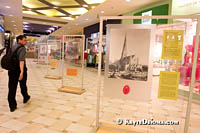 Another interesting spot worth visiting on the underworld web is thePromenades Cathédrale, a shopping mall built below an 1857 Cathedral. It is located toward the top of the left branch of the U near the McGill metro station. In the 1980s, the Christ Church Cathedral didn’t have enough money to do necessary repairs to their tilting tower, so they entered into partnership with a real estate developer to generate income. They created the KPMG Tower, a 35 story sky scraper, which reflects the cathedral, both in its glass façade and in its architectural details. Then they dug out from under the Cathedral and supported it on columns while
Another interesting spot worth visiting on the underworld web is thePromenades Cathédrale, a shopping mall built below an 1857 Cathedral. It is located toward the top of the left branch of the U near the McGill metro station. In the 1980s, the Christ Church Cathedral didn’t have enough money to do necessary repairs to their tilting tower, so they entered into partnership with a real estate developer to generate income. They created the KPMG Tower, a 35 story sky scraper, which reflects the cathedral, both in its glass façade and in its architectural details. Then they dug out from under the Cathedral and supported it on columns while 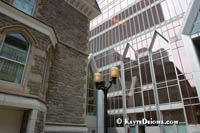 constructing an underground shopping center beneath. During this development, the Cathedral was in continual use, with the faithful entering the church via a footbridge. The rectory was dismantled stone by stone to make way for the tower to be built; then reassembled. It now houses Le Parchemin Restaurant. A photo display documenting the construction progress can be seen in the shopping passages below. A souvenir foldout booklet with photos and descriptions of the process can be obtained for free at the information desk.
constructing an underground shopping center beneath. During this development, the Cathedral was in continual use, with the faithful entering the church via a footbridge. The rectory was dismantled stone by stone to make way for the tower to be built; then reassembled. It now houses Le Parchemin Restaurant. A photo display documenting the construction progress can be seen in the shopping passages below. A souvenir foldout booklet with photos and descriptions of the process can be obtained for free at the information desk.
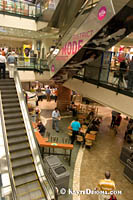 Beyond the central segment of the Underground City, other clusters of interconnected passages can be reached by riding the Metro for a few stops. Maps of the RESO can be obtained from most subway stations and hotels or downloaded from the internet. The underground network is also usually indicated on most maps of the downtown area.
Beyond the central segment of the Underground City, other clusters of interconnected passages can be reached by riding the Metro for a few stops. Maps of the RESO can be obtained from most subway stations and hotels or downloaded from the internet. The underground network is also usually indicated on most maps of the downtown area.
There are no regularly scheduled tours of the Underground City, but most of the local tour companies have guides you can hire to narrate your exploration of the RESO at your convenience. Many areas of the RESO, even in the recent additions, are not wheelchair accessible.
Hotels linked to the Underground City:
Queen Elizabeth Hotel
Chateau Champlain Hotel
Hilton Bonaventure
W Hotel
Hôtel InterContinental Montréal
Hotel Le St-James
Hotel Delta Centre-Ville
Hyatt Regency Montréal (Complexe Desjardins)
Montréal Marriott Château Champlain
Hôtel Gouverneur Place Dupuis – by Metro

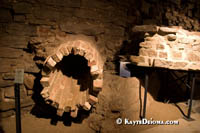 That’s what happened when the Society for Development of the Old Port had archaeologists survey the Pointe-ŕ-Calličre in Old Montreal with the intention of creating a park across from the Old Customs House. What they found were remnants of previous occupants of the site all the way back to the city’s founding in 1642. Stone walls of generations of earlier buildings had been built over the first Catholic cemetery where French settlers and Indians were buried side by side.
That’s what happened when the Society for Development of the Old Port had archaeologists survey the Pointe-ŕ-Calličre in Old Montreal with the intention of creating a park across from the Old Customs House. What they found were remnants of previous occupants of the site all the way back to the city’s founding in 1642. Stone walls of generations of earlier buildings had been built over the first Catholic cemetery where French settlers and Indians were buried side by side.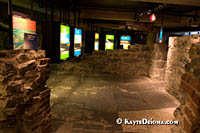 The archaeological site was deemed too important to be covered with a park. The challenge was how to preserve the site from deterioration, yet make it accessible to the public. The solution was the Pointe-ŕ-Calličre, Montréal Museum of Archaeology and History, also known as PAC. The museum was created by re-building Place Royal, the city’s first public square, and the new Éperon building overtop of the underground site in such a way that visitors could explore the excavation below. The underground passages extend under the Old Customs House, which was incorporated into the museum.
The archaeological site was deemed too important to be covered with a park. The challenge was how to preserve the site from deterioration, yet make it accessible to the public. The solution was the Pointe-ŕ-Calličre, Montréal Museum of Archaeology and History, also known as PAC. The museum was created by re-building Place Royal, the city’s first public square, and the new Éperon building overtop of the underground site in such a way that visitors could explore the excavation below. The underground passages extend under the Old Customs House, which was incorporated into the museum.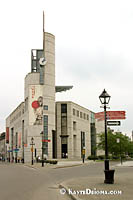 Pointe-ŕ-Calličre is the point formed by the joining of the Little St. Pierre River and the St. Lawrence River when the original French settlement of Ville Marie was established at this spot on the Island of Montreal. It was named for Louis-Hector de Calličre, third Governor of Montreal, who built his home here. The Little St. Pierre was later turned into a covered sewer system and then disappeared altogether. Although the little river is no more, the contemporary gray masonry façade and clock tower of the Éperon building conform to the shape of the point and the buildings that existed previously on this site. The entrance to the underground complex is through this modern structure.
Pointe-ŕ-Calličre is the point formed by the joining of the Little St. Pierre River and the St. Lawrence River when the original French settlement of Ville Marie was established at this spot on the Island of Montreal. It was named for Louis-Hector de Calličre, third Governor of Montreal, who built his home here. The Little St. Pierre was later turned into a covered sewer system and then disappeared altogether. Although the little river is no more, the contemporary gray masonry façade and clock tower of the Éperon building conform to the shape of the point and the buildings that existed previously on this site. The entrance to the underground complex is through this modern structure.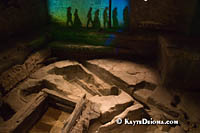 The primary exhibit at Pointe-ŕ-Calličre is the archaeological site itself, where you can see how an outhouse was situated above the graves in the first Catholic cemetery and wander among the stone walls to see how buildings were built on top of previous structures. You can walk where the Little St. Pierre River was channeled into the sewage canal with protruding brick conduits and you can see remains of Governor Calličre’s home.
The primary exhibit at Pointe-ŕ-Calličre is the archaeological site itself, where you can see how an outhouse was situated above the graves in the first Catholic cemetery and wander among the stone walls to see how buildings were built on top of previous structures. You can walk where the Little St. Pierre River was channeled into the sewage canal with protruding brick conduits and you can see remains of Governor Calličre’s home.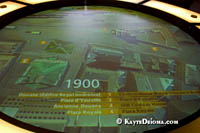 In addition to the excavated ruins, the artifacts found in the dig are displayed and interpreted according to the appropriate time period from Indian arrowheads to an 18 th century chamber pot and a 20 th century milk bottle. Multicolored information displays provide the history and significance of the times and the artifacts. A large interactive circular display lets you see the layout of the area in whatever time period you select. Glass windows in the floor show models of the neighborhood through the ages. At the far end toward the Customs House, motion-activated historic characters emerge
In addition to the excavated ruins, the artifacts found in the dig are displayed and interpreted according to the appropriate time period from Indian arrowheads to an 18 th century chamber pot and a 20 th century milk bottle. Multicolored information displays provide the history and significance of the times and the artifacts. A large interactive circular display lets you see the layout of the area in whatever time period you select. Glass windows in the floor show models of the neighborhood through the ages. At the far end toward the Customs House, motion-activated historic characters emerge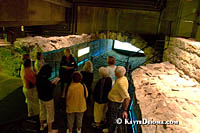 holographically from the stone walls to tell their story.
holographically from the stone walls to tell their story.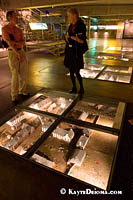 Free guided tours are available in English on Saturdays at 2:30 pm all year long with additional tours at the same time on Tuesdays, Thursdays and Sundays in the summer. French tours are at 1:30 pm on the same days.
Free guided tours are available in English on Saturdays at 2:30 pm all year long with additional tours at the same time on Tuesdays, Thursdays and Sundays in the summer. French tours are at 1:30 pm on the same days.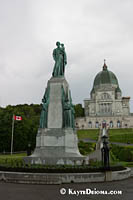 Montreal is a great city for exploring on your own and any of the venues in this issue would be perfectly appropriate to visit alone. But I somehow think of spiritual places as good solo destinations to take a quiet moment and ponder the universe. St. Joseph’s Oratory on Mount Royal is a nice spot for such pondering.
Montreal is a great city for exploring on your own and any of the venues in this issue would be perfectly appropriate to visit alone. But I somehow think of spiritual places as good solo destinations to take a quiet moment and ponder the universe. St. Joseph’s Oratory on Mount Royal is a nice spot for such pondering.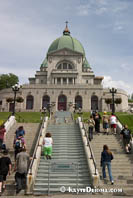 St. Joseph’s Oratory, at 856 feet (263 meters) above sea level, is the highest point in Montreal. From street level to the top of the dome is 506 feet (155 meters). That’s a lot of stairs to climb, especially if you are a pilgrim climbing the stairs on your knees. If you don’t feel like scaling the 233 steps up to the Crypt level, a shuttle will drive you from the gate house at street level up to the entrance.
St. Joseph’s Oratory, at 856 feet (263 meters) above sea level, is the highest point in Montreal. From street level to the top of the dome is 506 feet (155 meters). That’s a lot of stairs to climb, especially if you are a pilgrim climbing the stairs on your knees. If you don’t feel like scaling the 233 steps up to the Crypt level, a shuttle will drive you from the gate house at street level up to the entrance.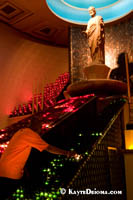 The Arrow Guide suggests entering the building from the side entrance into the Votive Chapel (marked with the number 1), a long corridor lined with votive altars. Each one is a tribute to St. Joseph in his various functions as model for workers, guardian of virgins, support of families, terror of demons, consolation of the afflicted, hope of the sick, patron of the dying, and protector of the Church. Halfway down the hall in the center lamp rack, 3,500 of the chapel’s 10,000 votive candles rise up to a statue of Joseph with arms outstretched. Between the altars, wooden crutches of those healed by Brother André are displayed hanging in rows. Notably, there are no aluminum crutches or other evidence of people being healed since the pious man’s passing.
The Arrow Guide suggests entering the building from the side entrance into the Votive Chapel (marked with the number 1), a long corridor lined with votive altars. Each one is a tribute to St. Joseph in his various functions as model for workers, guardian of virgins, support of families, terror of demons, consolation of the afflicted, hope of the sick, patron of the dying, and protector of the Church. Halfway down the hall in the center lamp rack, 3,500 of the chapel’s 10,000 votive candles rise up to a statue of Joseph with arms outstretched. Between the altars, wooden crutches of those healed by Brother André are displayed hanging in rows. Notably, there are no aluminum crutches or other evidence of people being healed since the pious man’s passing. To the left is the Crypt Church, so named for the flattened arches supporting the ceiling and its position at the foot of the Basilica. Rather than the traditional cross over the altar, a nine-foot statue of St. Joseph takes pride of place. The Christ statue on the large crucifix to the right of the altar has worn feet from the hands of many pilgrims. A giant statue of Brother André looms in front of the stained glass windows on the right wall. The colorful panels represent events in the life of St. Joseph.
To the left is the Crypt Church, so named for the flattened arches supporting the ceiling and its position at the foot of the Basilica. Rather than the traditional cross over the altar, a nine-foot statue of St. Joseph takes pride of place. The Christ statue on the large crucifix to the right of the altar has worn feet from the hands of many pilgrims. A giant statue of Brother André looms in front of the stained glass windows on the right wall. The colorful panels represent events in the life of St. Joseph.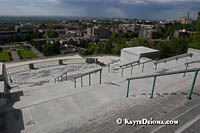 Doors at the back of the Crypt Church will take you to the escalators up to the Concourse Hall where you will find access to the terrace which provides a view of Montreal down the west side of Mount Royal. You’ll also find restrooms and drinking fountains on this floor and the stairway to theBrother André Display. You have to take the stairs, as the escalator bypasses this area. This exhibit contains recreations of the doorkeeper’s lodge at Notre Dame College, Brother André’s office and the hospital room where he died, some of them with original features. However the most important artifact in this display is the reliquary with Brother André’s heart.
Doors at the back of the Crypt Church will take you to the escalators up to the Concourse Hall where you will find access to the terrace which provides a view of Montreal down the west side of Mount Royal. You’ll also find restrooms and drinking fountains on this floor and the stairway to theBrother André Display. You have to take the stairs, as the escalator bypasses this area. This exhibit contains recreations of the doorkeeper’s lodge at Notre Dame College, Brother André’s office and the hospital room where he died, some of them with original features. However the most important artifact in this display is the reliquary with Brother André’s heart.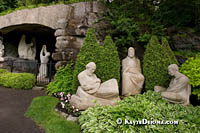 Back down on the Concourse level you can exit to the Way of the Crossand the Oratory Gardens. The larger-than-life Stations of the Cross lead through the gardens to the Pool and Fountain of Redemption. It’s a beautiful place to dwell and contemplate in nice weather, but if it’s raining significantly, you might want to proceed up the escalator to the OratoryMuseum.
Back down on the Concourse level you can exit to the Way of the Crossand the Oratory Gardens. The larger-than-life Stations of the Cross lead through the gardens to the Pool and Fountain of Redemption. It’s a beautiful place to dwell and contemplate in nice weather, but if it’s raining significantly, you might want to proceed up the escalator to the OratoryMuseum.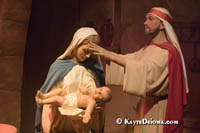 The front galleries are used for rotating exhibits from the Museum’s significant collection of artwork related to the Holy Family, St. Joseph and Brother André. Part of every year includes a Nativity Exhibit with 200 to 300 of the Museum’s thousands of crčches from around the world from the 6 th century through the present. Each annual exhibit includes at least 100 nativity scenes that have not been exhibited before. They range from miniatures to life size, from Indian needlework to Vietnamese Mother of Pearl, Sudanese ebony and incense paste from Singapore. The permanent exhibit at the back of the Museum is a series of wax figures behind glass portraying scenes from the life of St. Joseph.
The front galleries are used for rotating exhibits from the Museum’s significant collection of artwork related to the Holy Family, St. Joseph and Brother André. Part of every year includes a Nativity Exhibit with 200 to 300 of the Museum’s thousands of crčches from around the world from the 6 th century through the present. Each annual exhibit includes at least 100 nativity scenes that have not been exhibited before. They range from miniatures to life size, from Indian needlework to Vietnamese Mother of Pearl, Sudanese ebony and incense paste from Singapore. The permanent exhibit at the back of the Museum is a series of wax figures behind glass portraying scenes from the life of St. Joseph.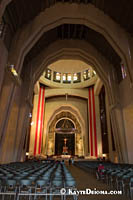 Above the museum is the Basilica. You can go back outside at this level to admire the 60 foot Corinthian columns close up and enjoy the view. This is the highest point you can climb if you’re ascending the 283 stars up the front of the Oratory. The interior dome rises 195 feet (60 m) above the floor. The cavernous space holds 2200 people seated in the metal folding chairs or 10,000 standing. It is rather stark in contrast to many basilicas in the world and less inviting than the cozy Crypt below. The dome is the third largest in the world after St. Peter’s in Rome and an African tribute to St. Peter’s, the Basilica of Our Lady of Peace in Ivory Coast. The stained glass windows depict some of the miraculous events in Canadian history attributed to the intervention of St. Joseph. The Grand Organ at the back of the Basilica has 5,811 pipes, with the longest 32 feet (9.75 m) tall. Organ recitals are every Sunday at 3:30 all year with a series of guest performances on Wednesday evenings in the summer.
Above the museum is the Basilica. You can go back outside at this level to admire the 60 foot Corinthian columns close up and enjoy the view. This is the highest point you can climb if you’re ascending the 283 stars up the front of the Oratory. The interior dome rises 195 feet (60 m) above the floor. The cavernous space holds 2200 people seated in the metal folding chairs or 10,000 standing. It is rather stark in contrast to many basilicas in the world and less inviting than the cozy Crypt below. The dome is the third largest in the world after St. Peter’s in Rome and an African tribute to St. Peter’s, the Basilica of Our Lady of Peace in Ivory Coast. The stained glass windows depict some of the miraculous events in Canadian history attributed to the intervention of St. Joseph. The Grand Organ at the back of the Basilica has 5,811 pipes, with the longest 32 feet (9.75 m) tall. Organ recitals are every Sunday at 3:30 all year with a series of guest performances on Wednesday evenings in the summer.